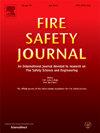A volumetric reaction model for the combustion of moist wood exposed to moderate thermal irradiances
IF 3.4
3区 工程技术
Q2 ENGINEERING, CIVIL
引用次数: 0
Abstract
An unsteady one-dimensional solid-phase model is formulated and experimentally validated for the glowing combustion of moist wood. Global reactions are considered for wood decomposition and char combustion, with volumetric rates, and a kinetic rate for moisture evaporation. Good agreement is found between the predicted and measured surface temperatures and mass fluxes for thick specimens and/or high heat fluxes. The effects of the moisture content (0–0.75 mass fractions on dry basis), specimen thickness (10–40 mm) and heat flux (18–50 kW/m2) are studied. The cases of combustion, athermic combustion (Δhc = 0) and pyrolysis are compared. Combustion may cause a pseudo steady state (simultaneous presence of the various zones propagating with roughly constant rates), comprised between short initial and final transients. The conversion time is mainly affected by the reaction heat with minor effects from surface regression. In fact, the characteristic times of athermic combustion and pyrolysis are very close. Compared with pyrolysis, the combustion heat also mitigates the influences of moisture evaporation on the conversion dynamics. The existence and duration of the pseudo steady state are enhanced by high values of specimen thickness and moisture content and external heat fluxes.
湿木材暴露在中等热辐照下燃烧的体积反应模型
建立了一维非定常湿木材燃烧的固相模型,并进行了实验验证。考虑了木材分解和炭燃烧的整体反应,具有体积速率和水分蒸发的动力学速率。对于厚样品和/或高热通量,预测的表面温度和测量的表面温度和质量通量之间存在很好的一致性。研究了湿含量(0-0.75质量分数)、试样厚度(10-40 mm)和热流密度(18-50 kW/m2)的影响。比较了燃烧、热燃烧(Δhc = 0)和热解的情况。燃烧可能导致伪稳态(同时存在以大致恒定速率传播的各种区域),包括短暂的初始瞬态和最终瞬态。反应时间主要受反应热的影响,表面回归的影响较小。事实上,热燃烧和热解的特征时间非常接近。与热解相比,燃烧热也减轻了水分蒸发对转化动力学的影响。高的试样厚度、高的含水率和高的外部热通量增强了伪稳态的存在和持续时间。
本文章由计算机程序翻译,如有差异,请以英文原文为准。
求助全文
约1分钟内获得全文
求助全文
来源期刊

Fire Safety Journal
工程技术-材料科学:综合
CiteScore
5.70
自引率
9.70%
发文量
153
审稿时长
60 days
期刊介绍:
Fire Safety Journal is the leading publication dealing with all aspects of fire safety engineering. Its scope is purposefully wide, as it is deemed important to encourage papers from all sources within this multidisciplinary subject, thus providing a forum for its further development as a distinct engineering discipline. This is an essential step towards gaining a status equal to that enjoyed by the other engineering disciplines.
 求助内容:
求助内容: 应助结果提醒方式:
应助结果提醒方式:


